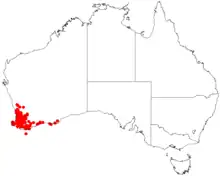| Lepidosperma leptostachyum | |
|---|---|
| Scientific classification | |
| Kingdom: | Plantae |
| Clade: | Tracheophytes |
| Clade: | Angiosperms |
| Clade: | Monocots |
| Clade: | Commelinids |
| Order: | Poales |
| Family: | Cyperaceae |
| Genus: | Lepidosperma |
| Species: | L. leptostachyum |
| Binomial name | |
| Lepidosperma leptostachyum | |
 | |
| Occurrence data from AVH | |
Lepidosperma leptostachyum is a species of flowering plant in the sedge family, Cyperaceae, a native of Southwest Australia.
Taxonomy
The first description was given in an 1878 monograph by George Bentham, published in the Flora of Australia series.[1]
The diversity of the genus Lepidosperma has been the subject of frequent revision, and a variety of this species is recognised, Lepidosperma leptostachyum var. asperatum Kük.[2] The name has been applied to populations later recognised as a new species, Lepidosperma apricola R.L. Barrett, in 2013.[3]
Description
Lepidosperma leptostachyum is herbaceous or grass-like in form, growing as clumps around 600 millimetres across. The height is an equivalent size or as low as 100 mm, the plant may be up to 1 metre in height. The brownish inflorescence appears from April to June.[1]
Distribution and habitat
The species is found in the Southwest Australia region, in a variety of soil types. They occur on slopes, on black and grey sands, lateric and peaty soils, or clay, and on gravel.[1]
The conservation status of L. leptostachyum is noted at FloraBase as not threatened.[1]
References
- 1 2 3 4 "Lepidosperma leptostachyum". FloraBase. Western Australian Government Department of Biodiversity, Conservation and Attractions.
- ↑ Barrett, R.L.; Wilson, K.L. (2012). "A review of the genus Lepidosperma Labill. (Cyperaceae: Schoeneae)". Australian Systematic Botany. 25 (4): 225. doi:10.1071/SB11037.
- ↑ Barrett, R.L.; Wilson, K.L. (2013). "Two new species of Lepidosperma (Cyperaceae) occurring in the Perth area of Western Australia". Nuytsia. 23: 173–187.